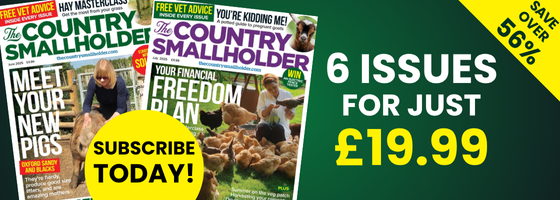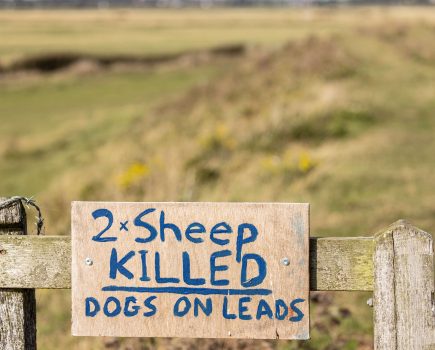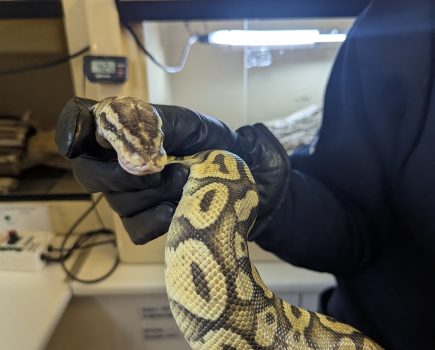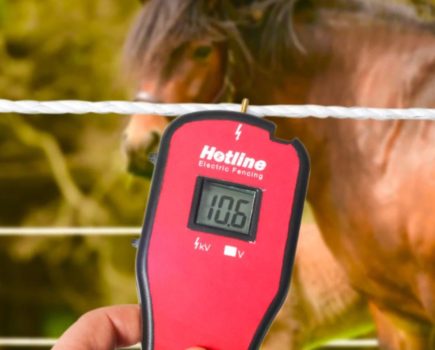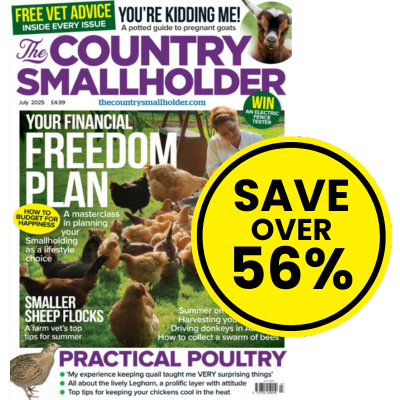Debbie Street heads Down Under to give a clinic to Australian carriage drivers, with skills that work worldwide.
Summer 2024 was quite an adventure for the Street family. After much careful planning, we were finally able to fulfil a long-standing request from Pat and Barry Emmet and the council and members of the Donkey All Breeds Society of Australia to run a driving clinic Down Under.
As you might expect, I carefully assessed and planned the sessions in advance. By asking questions online and looking at videos and photos, I could see that there was a huge range of experience and ability amongst the folk wanting to take the course.
What immediately became clear was that even the inexperienced drivers had good equine or farming skills. They were riders or experienced animal handlers. Just a basic course in long reining and driving would not really cut it. They needed advanced skills alongside the basic ones, and it had to be an enjoyable experience for both animals and drivers.
Whilst teaching carriage driving with donkeys over the last twenty years, I have found that two areas, donkey psychology combined with traditional rein skills, are crucial for promoting happy driving donkeys who offer free forward movement, good transitions, and excellent turning. So, for the DABSA Australian Clinics these two became the main topics for study and practise, alongside sessions upon correct harnessing, putting to, and pulling a sledge for the first time.
Students were planning to travel huge distances across Australia to reach a central point to make the clinic viable. They were flying from as far away as Queensland or driving 9 hours up from Victoria. Not everyone could bring their own donkeys. Students and owners who were within travelling distance were bringing many of their own donkeys so that others could share; a wide range of donkey breeds from miniature to mammoth, including a mule.
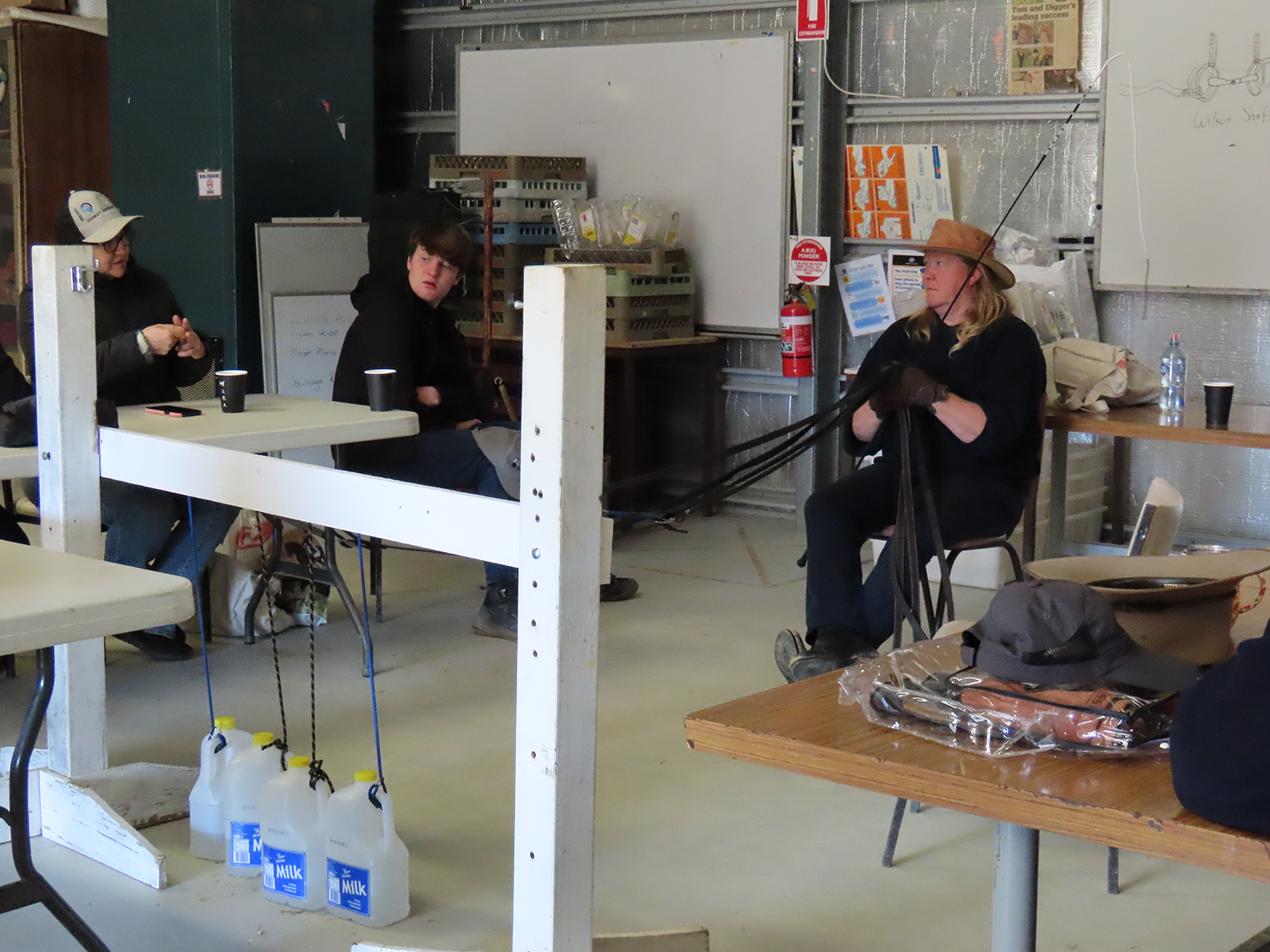
The rein machine, (made from plastic bottles and a simple set of four pulleys) was used to demonstrate how to use the reins to steer
I decided at this point, that a focus upon rein skills was needed. By really looking closely at how rein aids can replace leg aids to produce good forwards movement through turns, circles, and upwards as well as downwards transitions, we could really make the most out of the teaching time. To ensure that everyone could actively practise, I asked DABSA to make a ‘rein machine’. I also planned sessions where people could work in pairs to improve their rein skills before working the donkeys.
The first topic for discussion, demonstration and practice was about why English Coachman’s is so good for schooling donkeys to drive. This is because firstly, donkeys move more freely forwards as steering becomes more subtle and secondly, you can put your ‘leg on’ and drive forwards through turns and transitions instead of accidentally stopping your donkey. We also practised the difference between incline turns and acute turns and how these affect the donkeys’ way of going.
The second session covered how donkey psychology is crucial in training as a donkey thinks very differently to a horse or pony. They have a strong oppositional reflex when presented with danger or anxiety and their flight or fight responses are dependent upon thought as well as physical strength. When confronted with a predator they tend to freeze, think, aim, kick, bite, crush, then bolt short distances whilst bucking and thinking. Horses think after they have bolted, their flight instinct is so fast they usually run, then think, to avoid danger via speed.
A donkey needs to be trained intellectually, then he/she will work out how to use its body to carry out those tasks. A horse is often better taught kinaesthetically; they thrive upon moving whilst understanding aids and commands. So, training a donkey to drive athletically via horse training methods simply teaches the donkey to evade the work, or conscientiously plod along. They are intellectuals with physical stamina not sprinting athletes.
WHY REIN HANDLING IS IMPORTANT
English Coachman Rein skills correctly applied communicate very clearly to the donkey because they give the driver a four stage method of communication in a sensitive clear manner. The reins are held in the left hand in a way that keeps the donkey going straight and can be used to make incline turns. The right hand assists the left to make acute turns and transitions. The position the hands and lower arms are placed in make their very manner sensitive and clear.
During my teaching I show the driver how English Coachman’s can incorporate donkey psychology to use the rein in a four stage sequence, too lightly, lightly, clearly, then firmly, every time he/she makes a request. This is so important with donkeys because should they obey at the light or clear stage the driver quits asking. With two handed driving this is very difficult to achieve with donkeys. Students of driving are amazed to find that what they thought was a light turning touch was prematurely applied firmly inadvertently telling the donkey to stop, especially when trying to turn in trot.
English Coachman’s provides a whole palette of communicative aids right at your fingertips to promote forwards movement and accuracy through turns and circles, and for maintaining impulsion through transitions. For example, as C. Morley Knight writes: 1‘The thumb must not be pressed down on the rein, except when a loop is taken up to turn a corner to the right or left’.
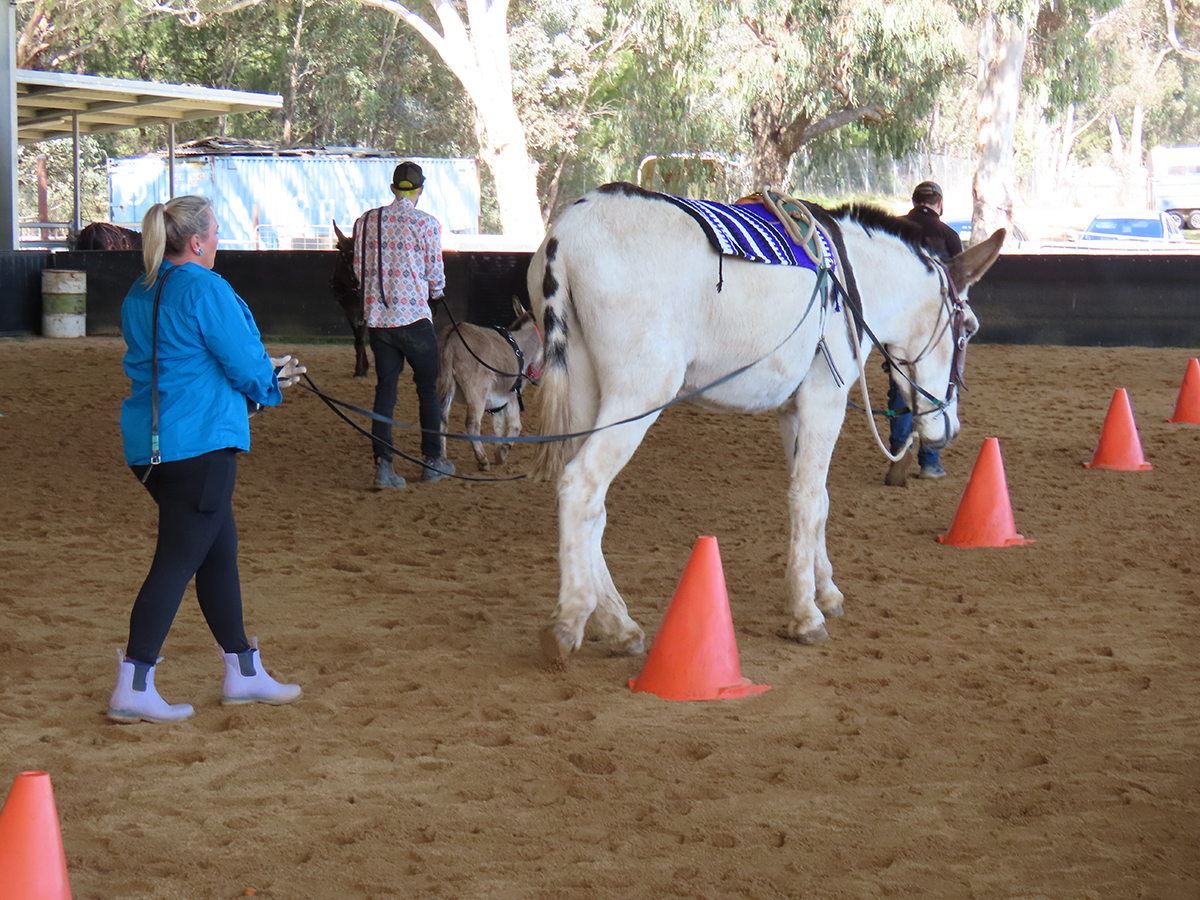
The Mammoth donkey long reining around the cones is Sultan, being long reined by Emma Burstall
Pressing a thumb down stops the forward movement of the donkey, English Coachman’s allows you to loop (point) the reins to turn with consistency using the too lightly, lightly, clearly, firmly sequence without stopping to think about it and fluent movement is maintained. However, to achieve this during a driving clinic takes dedication on the part of the trainer and students, so the second day of the course we revised using the rein machine and then put theory into practise whilst long reining the donkeys.
Teaching styles included discussions, visual whiteboards, rein machine, working in pairs with the rein skills, demonstrations and practise long reining miniatures, bush donkeys, standard donkeys, various breeds of large donkey, a mammoth donkey and a mule. We had question and answer sessions. We also examined how to use the whip for communication not coercion and examined how to balance the whip in the hand.
The whip is a communication aid and can soothe, persuade, explain and advise an equine. Hugh Smith-Baille warns: 2 ‘Do not hold the whip at the end but hold it so that it will balance well in the hand.’
A balanced whip can protect the mouth of a donkey by helping to steer with a touch on the shoulder. A correctly balanced whip becomes easy to use for a variety of communications. If you grip this whip with the fingers, it is impossible to use it as a subtle and discursive aid, it just becomes either too demanding or too vague. Gripping the whip in your right hand also makes it impossible to use the right fingers upon the reins and tempts you to place the whip behind the pad which can create bucking or is just ignored by the donkey as it makes no sense.
In the afternoon of the second day, we worked out and about on the cross country course, stepping over logs, over bridges, around trees and all the hazards. We looked at how to manage separation anxiety and how to use spatial awareness and the timing of aids to refocus the distracted or hesitant donkey.
In the evening, we enjoyed a harnessing and putting to a carriage demonstration, and discussed various items of harness, for example the differences between a breast collar and a full collar.
On the third day we moved on to carriage driving, driving circles, starter pear drop turn figures of eight, full proper circle figures of eight, increasing and decreasing circles, slaloms and obstacles.
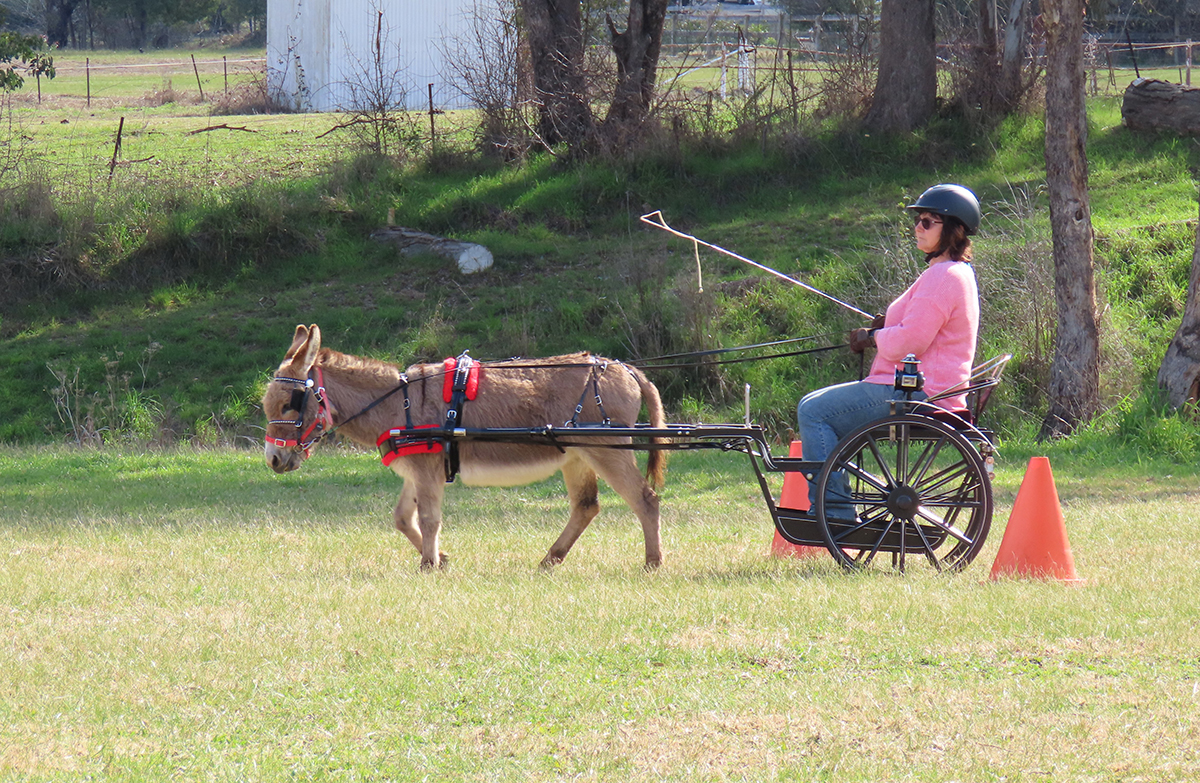
Tarangbar Heaven from Joy’s miniatures is the Miniature driving donkey. She is being driven by Joy Young who is making a left incline turn
We incorporated all the skills above making it clear how the skills change from long reining to driving and practising the progression. The differences between starting the driven donkey in comparison to the driven horse or pony were referred to throughout both theory and practical sessions. We also moved on to look at individual needs. Students had specific lessons on how to start the reluctant donkey, how to organise a groom or grooms, putting a mule to a sledge safely.
Advanced students went on to learning how to handle four reins for tandem and team driving. We also covered a theoretical and a practical session upon trailer loading the reluctant donkey.
Everyone on the course was exceptionally dedicated, days were long and full of activity, everyone threw themselves into every task with enthusiasm. Their donkeys were very busy.
I was extremely impressed by the students’ ability to learn. I am very keen to support this learning any way I can going forward. I would also love to encourage more people to carriage drive their donkeys and mules.
Debbie can be contacted at www.donkeydriving.co.uk
1. C. Morley Knight, Hints on Driving, (J.A.Allen and Co, Ltd, London, 1991) p. 26. Also available free online as a free PDF Hints on Driving, by Captain C. Morley Knight-A Project Gutenberg eBook.
2. Hugh Smith-Baille, Chapter, ‘Hints to Beginners’ from Driving, The Badminton Library, ed. His Grace the 8th Duke of Beaufort, (Ashford Press Publishing, Southampton, 1986), p. 132.
Top image: Debbie Street discussing how to drive English Coachman’s style and why it is preferred by donkeys.
This article first appeared in the July 2025 edition of The Country Smallholder. You can buy the full issue here.



